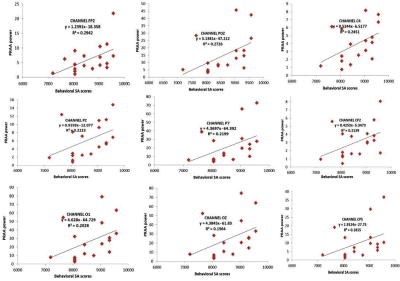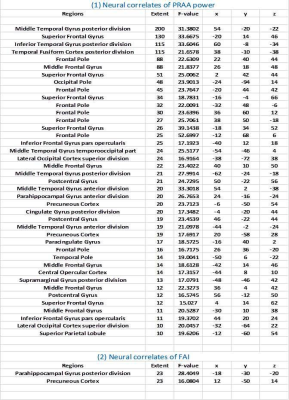4515
Does Pre-task Resting state Absolute Alpha (PRAA) power and its Frontal Asymmetry Index (FAI) predict outcome of Situational Awareness task? Assessment through EEG informed fMRI approach.1Nuclear Magnetic Resonance Research Center, Institute of Nuclear Medicine & Allied Sciences, Defence Research and Development Organisation, Delhi, India, 2Applied Physics, Delhi Technological University, Delhi, India
Synopsis
One of the established hypotheses is that alpha-oscillation inhibits irrelevant stimulus processing during task, but correlates positively with emotional stability of individual in absence of predefined task. However, role of Pre-task Resting state Absolute Alpha rhythm (PRAA) and its frontal hemispheric difference estimated by Frontal Asymmetry Index (FAI) in predicting the outcome of individual’s performance in higher-order cognitive task is poorly understood. Thus, in this study, correlation of PRAA and FAI with behavioral parameter pertaining to Situational Awareness (SA) task was studied. Further, to substantiate the emotional connectivity of PRAA and FAI index, their neural correlates in task-fMRI were estimated.
Purpose
To validate the proposed hypothesis that PRAA rhythm and its frontal hemispheric difference predicts outcome of subsequently performed higher order cognitive task (Situational-Awareness) and to estimate their neural correlates in task-fMRI data.Methods
Eighteen healthy volunteers (Mean age= 24 years) participated in resting-state EEG and SA task study. Pre-task resting-state EEG data was acquired using MR-compatible 32-channel electrodes prior to SA task-fMRI acquisition. SA task was designed as per Endsley theory1 and volunteers were asked to respond queries in periodic interval for purpose of assessing their SA. Both EEG and fMRI acquisitions were carried out inside 3T MRI machine without changing position of volunteers. At first, PRAA powers (8-13 Hz) for all channels and FAI using frontal channels FP1,FP2,F3,F4,F7 and F8 were computed from resting-state EEG data for all volunteers. FAI was estimated by subtracting logarithmic alpha of left-hemisphere from logarithmic alpha of right-hemisphere. SA behavioural2 scores were estimated as 0.5+ (H-F) (1+H-F)/4H (1-F); where H and F are hit rate and false rate respectively. Then, correlation of SA scores with PRAA power for each channel was estimated. Channels whose correlation was higher than 0.404 with p value < 0.094 were grouped and their alpha band average was passed as global covariates in second level analysis of general linear model(GLM). Further, correlation of SA score with FAI was estimated and passed as global covariates in another GLM model. Both models were subjected to one way analysis of variance (ANOVA) with contrast seeking neural correlates of PRAA and FAI index and results were inferred using F-test.Results
Behavioural and physiological result:
Plot between significantly correlating channel’s (fp2, poz, c4, pz, p7, cp2, o1, oz, cp5) PRAA power and SA scores of every individual is shown in Figure 1. Similarly, the correlation plot of SA score and FAI of all participants is shown in Figure 2.
Neuroimaging result:
The neural correlates of PRAA were found primarily in middle temporal gyrus, superior frontal gyrus, frontal pole, middle frontal gyrus, inferior frontal gyrus, inferior temporal gyrus, temporal fusiform gyrus, para-hippocampal gyrus, occipital pole, lateral occipital cortex, precuneous cortex and posterior cingulate gyrus (Figure 3). FAI significantly correlated with para-hippocampal gyrus and precuneous cortex (Figure 4). The results were computed at p<0.001 and clusters with size>10 have been considered (Table 1).
Discussion
The high positive correlation of the SA scores with PRAA of 9 channels and with FAI supports the proposed hypothesis that PRAA rhythm and FAI can predict the outcome of an individual in higher cognitive tasks. Previous findings3 showed a positive correlation between absolute powers of alpha rhythm and the C factor by the Cattel’s questionnaire (emotional stability/instability). Similarly, Hemispheric asymmetry has been known to predict the approach or avoidance attitude of a person towards any situation4. The neural correlates of PRAA powers were found in superior frontal gyrus, middle frontal gyrus which is primarily involved in emotional regulation through suppression5. The neural basis of cognitive control of emotion was studied in left prefrontal cortex and medial prefrontal cortex6, while inferior orbitofrontal cortex is linked to neurophysiological arousal related with emotion. Activation of medial prefrontal, temporal and precuneous regions while introspecting has been reported in one of the studies7. This goes in sync with other correlating areas such as frontal pole, middle frontal gyrus, superior frontal gyrus, inferior frontal gyrus. The high threat processing8 is known to be associated with middle frontal gyrus, inferior frontal gyrus which forms key nodes of the attentional network. These findings allow us to revisit relationship between emotion and cognition where emotional state is known to trigger signals that may drive cognition and ultimately lead to a decision. The neural correlates of FAI found significant activations in parahippocamal gyrus and precuneous. People with social anxiety disorder showed hyperactivity9 in amydala, parahippocampal gyrus and precuneous is mainly involved in introspection.Conclusion
Our results validates proposed hypothesis that PRAA rhythm and its FAI can predict the emotional state of an individual prior to task, which affects outcome of subsequently performed higher order cognitive task (Situational-Awareness) .Acknowledgements
No acknowledgement found.References
1. Endsley,M.R. Toward a Theory of Situation Awareness in Dynamic Systems. Human Factors Journal. 1995;37(1):32-64.
2. Stanislaw H, Todorov N. Calculation of signal detection theory measures. Behav Res Methods Instrum Comput. 1999;31(1):137-49.
3. Pavlenko, V.B, Chernyi, S.V & Goubkina, D.G. EEG Correlates of Anxiety and Emotional Stability in Adult Healthy Subjects. Neurophysiology. 2009;41(5):337–345.
4. Balconi M, Vanutelli ME, Grippa E. Resting state and personality component (BIS/BAS) predict the brain activity (EEG and fNIRS measure) in response to emotional cues. Brain Behav. 2017;7(5):e00686.
5. Blair KS, Smith BW, Mitchell DG, Morton J, et al. Modulation of emotion by cognition and cognition by emotion. Neuroimage. 2007;35(1):430-40.
6. Ochsner KN, Bunge SA, Gross JJ, Gabrieli JD. Rethinking feelings: an FMRI study of the cognitive regulation of emotion. J Cogn Neurosci. 2002;14(8):1215-29.
7. Silani G, Bird G, Brindley R, Singer T, Frith C, Frith U. Levels of emotional awareness and autism: an fMRI study. Soc Neurosci. 2008;3(2):97-112.
8. Pessoa L. How do emotion and motivation direct executive control?. Trends Cogn Sci. 2009;13(4):160-6.
9. Etkin A, Wager TD. Functional neuroimaging of anxiety: a meta-analysis of emotional processing in PTSD, social anxiety disorder, and specific phobia. Am J Psychiatry. 2007;164(10):1476-88.
Figures




Table 1 Neural correlates of (1) pre-task resting-state absolute alpha (PRAA) and (2) frontal asymmetry index (FAI)